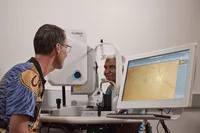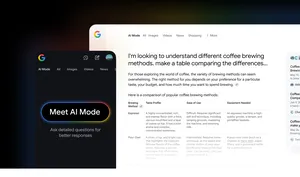An eye to the future: How AI could help to improve detection of eye disease in Australian communities

Editor’s note: This blog post is penned by our partner and guest author, Associate Professor Angus Turner, Director of Lions Outback Vision. He is an internationally recognised pioneer of teleophthalmology and has established a mobile service that spans regional Western Australia. The Lions Eye Institute is a global centre for quality eye care and scientific research into the treatment and prevention of blindness. This research collaboration builds on Google Australia’s Reconciliation Action Plan (addressing inequalities with Google’s unique capabilities) and is part of Google’s Digital Future Initiative – a five-year investment in Australian infrastructure, research and partnerships.
In Indigenous Australian communities, a common cause of vision loss is due to diabetic retinopathy – a disease that creates lesions in the back of the retina and can lead to blindness.
Diabetic-induced vision loss is 14 times more common in Indigenous people than non-Indigenous, and diabetes itself is three to five times more common across all age bands in the Indigenous population.
With early detection and treatment, blindness can be prevented. Unfortunately, this illness can go undetected if patients do not undergo screening. This is a growing health concern for our nation, particularly as access to doctors and healthcare services can be limited in rural and remote areas.
For 13 years, Lions Outback Vision at The Lions Eye Institute has been dedicated to finding ways to bridge this equity gap. And through a new collaboration with Google, we’re researching AI solutions to make screening more accessible and efficient, so we can detect eye disease earlier on in the patient journey.
As part of this partnership, we conducted a study to validate the performance of Google’s AI model to detect diabetic retinopathy within an Indigenous population in Western Australia. The retrospective study was based on anonymised data – and was conducted in partnership with Derbarl Yerrigan Health Service. The paper was recently published in the British Journal of Ophthalmology (BJO) this February and found that the machine learning model performs on-par with a retinal specialist.
Dr Angus Turner planning patient treatment with retinal specialist, Vaibhav Shah, at the Kimberley Hub, Broome.

Validating the model across diverse patient populations is critical to determine the role and potential of this technology in a clinical setting, and can help to reduce racial bias in AI models. Around the world, Google’s CE-marked AI system is already assisting clinicians and community health workers screen for diabetic retinopathy, and is deployed in India and Thailand.
We are proud to be involved in Google’s first ARDA (Automated Retinal Disease Assessment Software) research initiative in Australia. It’s a small but important step forward in our effort to improve retinopathy screening for Indigenous Australians.

